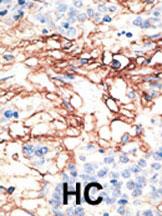

| WB | 咨询技术 | Human,Mouse,Rat |
| IF | 咨询技术 | Human,Mouse,Rat |
| IHC | 1/100-1/500 | Human,Mouse,Rat |
| ICC | 技术咨询 | Human,Mouse,Rat |
| FCM | 咨询技术 | Human,Mouse,Rat |
| Elisa | 咨询技术 | Human,Mouse,Rat |
| Aliases | DNA dC->dU-editing enzyme APOBEC-3G, 354-, APOBEC-related cytidine deaminase, APOBEC-related protein, ARCD, APOBEC-related protein 9, ARP-9, CEM-15, CEM15, Deoxycytidine deaminase, A3G, APOBEC3G |
| Entrez GeneID | 60489 |
| WB Predicted band size | 46.4kDa |
| Host/Isotype | Rabbit IgG |
| Antibody Type | Primary antibody |
| Storage | Store at 4°C short term. Aliquot and store at -20°C long term. Avoid freeze/thaw cycles. |
| Species Reactivity | Human |
| Immunogen | This CEM15 antibody is generated from rabbits immunized with a KLH conjugated synthetic peptide between 5-35 amino acids from the N-terminal region of human CEM15. |
| Formulation | Purified antibody in PBS with 0.05% sodium azide,1%BSA and 50% glycerol.prepared by Saturated Ammonium Sulfate (SAS) . |
+ +
以下是关于CEM15(N-term)抗体的3篇文献摘要信息,供参考:
---
1. **文献名称**: *Isolation of a human gene that inhibits HIV-1 infection and is suppressed by the viral Vif protein*
**作者**: Sheehy, A.M. et al.
**摘要**: 该研究首次报道了CEM15(后命名为APOBEC3G)作为HIV-1的限制因子,其N端结构域对病毒抑制起关键作用。研究中利用针对N端的特异性抗体验证了CEM15在宿主细胞内的表达及其与HIV-1 Vif蛋白的互作机制。
2. **文献名称**: *DNA deamination mediates innate immunity to retroviral infection*
**作者**: Harris, R.S. et al.
**摘要**: 文章阐明了APOBEC3G(CEM15)通过N端结构域的DNA脱氨酶活性抑制逆转录病毒复制。实验中通过N-term特异性抗体进行免疫印迹分析,证实了其在HIV-1感染细胞中的抗病毒功能及亚细胞定位。
3. **文献名称**: *Cytidine deamination of retroviral DNA by diverse APOBEC proteins*
**作者**: Chiu, Y.L. et al.
**摘要**: 本研究比较了APOBEC家族蛋白(包括CEM15)的抗病毒机制,重点分析了N端结构域的功能差异。利用CEM15 N-term抗体进行免疫共沉淀实验,揭示了其与其他宿主蛋白的相互作用网络及对病毒突变的调控作用。
---
以上文献均聚焦于CEM15(APOBEC3G)的N端结构域功能及抗体应用,涵盖抗病毒机制、结构分析和实验验证。如需具体实验细节或更多文献,可进一步检索PubMed或相关数据库。
The CEM15 (N-term) antibody is designed to target the N-terminal region of CEM15. a protein also known as APOBEC3G (apolipoprotein B mRNA-editing enzyme catalytic polypeptide-like 3G). APOBEC3G is a member of the APOBEC family of cytidine deaminases, which play critical roles in innate immunity by restricting viral infections. Specifically, APOBEC3G inhibits HIV-1 replication by inducing hypermutations in the viral genome during reverse transcription, rendering the virus non-infectious. However, HIV-1 counteracts this defense mechanism through its viral infectivity factor (Vif), which promotes APOBEC3G degradation via the proteasome.
The CEM15 (N-term) antibody is commonly used in research to detect and study the expression, localization, and functional dynamics of APOBEC3G. By targeting the N-terminal domain, this antibody helps investigate post-translational modifications, protein-protein interactions (e.g., with Vif), and regulatory mechanisms underlying APOBEC3G's antiviral activity. It is widely applied in techniques such as Western blotting, immunoprecipitation, and immunofluorescence. Research involving this antibody has contributed to understanding host-pathogen interactions, particularly in HIV biology, and explores therapeutic strategies to enhance APOBEC3G's antiviral function or block Vif-mediated degradation. Its specificity for the N-terminal region ensures recognition of full-length APOBEC3G or relevant isoforms, aiding studies on its structural and functional roles in viral restriction and immune regulation.
×